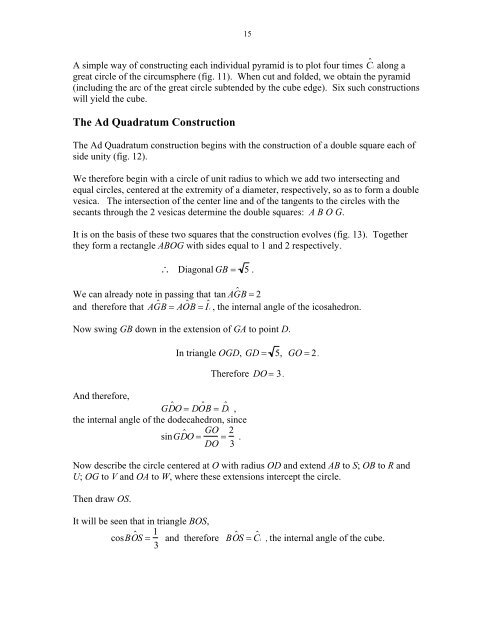Ad Quadratum Construction and Study of the Regular Polyhedra
Ad Quadratum Construction and Study of the Regular Polyhedra
Ad Quadratum Construction and Study of the Regular Polyhedra
Create successful ePaper yourself
Turn your PDF publications into a flip-book with our unique Google optimized e-Paper software.
15<br />
A simple way <strong>of</strong> constructing each individual pyramid is to plot four times C ˆ i along a<br />
great circle <strong>of</strong> <strong>the</strong> circumsphere (fig. 11). When cut <strong>and</strong> folded, we obtain <strong>the</strong> pyramid<br />
(including <strong>the</strong> arc <strong>of</strong> <strong>the</strong> great circle subtended by <strong>the</strong> cube edge). Six such constructions<br />
will yield <strong>the</strong> cube.<br />
The <strong>Ad</strong> <strong>Quadratum</strong> <strong>Construction</strong><br />
The <strong>Ad</strong> <strong>Quadratum</strong> construction begins with <strong>the</strong> construction <strong>of</strong> a double square each <strong>of</strong><br />
side unity (fig. 12).<br />
We <strong>the</strong>refore begin with a circle <strong>of</strong> unit radius to which we add two intersecting <strong>and</strong><br />
equal circles, centered at <strong>the</strong> extremity <strong>of</strong> a diameter, respectively, so as to form a double<br />
vesica. The intersection <strong>of</strong> <strong>the</strong> center line <strong>and</strong> <strong>of</strong> <strong>the</strong> tangents to <strong>the</strong> circles with <strong>the</strong><br />
secants through <strong>the</strong> 2 vesicas determine <strong>the</strong> double squares: A B O G.<br />
It is on <strong>the</strong> basis <strong>of</strong> <strong>the</strong>se two squares that <strong>the</strong> construction evolves (fig. 13). Toge<strong>the</strong>r<br />
<strong>the</strong>y form a rectangle ABOG with sides equal to 1 <strong>and</strong> 2 respectively.<br />
Diagonal GB 5 .<br />
We can already note in passing that tan A ˆ G B 2<br />
<strong>and</strong> <strong>the</strong>refore that A ˆ G B A ˆ O B ˆ I i , <strong>the</strong> internal angle <strong>of</strong> <strong>the</strong> icosahedron.<br />
Now swing GB down in <strong>the</strong> extension <strong>of</strong> GA to point D.<br />
In triangle OGD, GD 5, GO 2.<br />
Therefore DO 3.<br />
And <strong>the</strong>refore,<br />
G ˆ D O D ˆ O B ˆ D i ,<br />
<strong>the</strong> internal angle <strong>of</strong> <strong>the</strong> dodecahedron, since<br />
sinG ˆ D O GO 2<br />
<br />
DO 3 .<br />
Now describe <strong>the</strong> circle centered at O with radius OD <strong>and</strong> extend AB to S; OB to R <strong>and</strong><br />
U; OG to V <strong>and</strong> OA to W, where <strong>the</strong>se extensions intercept <strong>the</strong> circle.<br />
Then draw OS.<br />
It will be seen that in triangle BOS,<br />
cosB ˆ<br />
O S 1<br />
3<br />
<strong>and</strong> <strong>the</strong>refore B ˆ<br />
O S ˆ<br />
C i , <strong>the</strong> internal angle <strong>of</strong> <strong>the</strong> cube.




